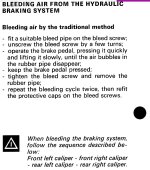It took for ages to bleed the brakes and M & D called me in for dinner before I was done. Next day I finally got the brakes bled, firm pedal, etc. and went for a test drive. Brakes were fine but I could hear a rattle under the car.
Upon examination I found that one of the ring spanners was still around the brake pipe! It had obviously slipped down the pipe well away from the union which I did up with open ended spanners.
I was temped to just tape the spanner in a position up out of the way but decided to split the union and remove it. Fortunately the brakes bled OK this time round.
I learnt a lot on those two days about:
1) Preparation and plan of attack, tools required
2) Tool tally - bit like a surgeon have the tools laid out as best as you can so you can use and replace and then check afterwards
3) If you drop a tool, nut, bolt, etc. stop what you are doing and retrieve said item even if it take forever (until found it could be disastrous)
4) Check and double check every aspect of the job and tool tally when done
Sadly as we get more experienced we often tend to be less attentive / regimented.
Worse still as you get into your retirement years you pick a tool up, use it, put it down and then can't find it again



